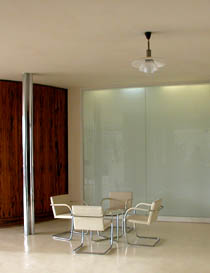
Brno wants to transfer the Tugendhat villa to the state, which is supposed to return it to the heirs
 |
All political clubs in the council agreed today that it is morally right to return the villa to the heirs. However, they differed in their opinions on the method. The transfer to the state was proposed by Mayor Roman Onderka (ČSSD). "This is a way to enable the return to take place. The issue of restitution has always been dealt with by the state in the Czech Republic," Onderka said.
The meeting of the council was attended by two daughters of the original owners, the Tugendhat couple. "Our intention is to keep the villa open to the public. We will strive for a quick and professional reconstruction," said Daniela Hammer-Tugendhatová to the councilors. She was confused by the representatives' decision. "It is an unclear solution, we don't understand it much. The problem has just been shifted to a higher level," she told reporters.
The opposition ODS proposed in a two-hour debate on the fate of the villa that the city should immediately and gratuitously donate it to the Tugendhats based on the law on municipalities. "What was stolen should be returned," said councilor Leo Venclík. The Civic Democrats were also concerned that the transfer to the state would delay necessary repairs to the villa. "We are passing this hot potato into someone else's garden," councilor Petr Paulczynski believes.
The coalition parties eventually pushed through Onderka's proposal, while ODS abstained from voting. The city council must prepare the materials for the transfer by February 15. The document that will then be presented to the council must clarify the circumstances of the transfer and also address the financing of the repairs.
The villa has been listed as the only Czech building of modern architecture on the UNESCO list since 2001. The building in the residential neighborhood of Černá Pole was designed in 1928 by the German architect Ludwig Mies van der Rohe. According to experts, it is unique in its spatial concept, selection of materials, and furnishings.
Its owners, Gréta and Fritz Tugendhat, came from families of prominent textile entrepreneurs. They occupied the house until 1938 when the family emigrated to Switzerland and then to Venezuela to escape the Nazis. After the Nazis occupied Czechoslovakia, the villa was confiscated by the Gestapo in 1940, and in 1945, it was seized by the then Czechoslovak state as Nazi property.
The English translation is powered by AI tool. Switch to Czech to view the original text source.
2 comments
add comment
Subject
Author
Date
Darování vily - proč ne ?
Chábera
31.01.07 07:15
Proč vilu nedarovat majitelům
Janek
01.02.07 07:15
show all comments
Related articles
0
31.05.2024 | The Tugendhat family did not enjoy their famous villa in Brno very much
1
31.12.2009 | Vila Tugendhat will close today for restoration
0
21.05.2009 | European experts will evaluate the restoration plan for the Tugendhat villa
1
09.03.2009 | Diary: Heritage experts set a deadline for the renovation of the Tugendhat Villa in Brno












